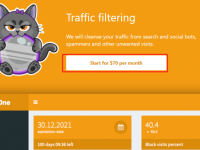How Cloaking Technology Powers Grey-Area E-commerce Advertising
①. What Is “Cloaking” in E-commerce Marketing?
In the world of grey-area e-commerce—such as independent fashion stores inspired by premium brands—cloaking is not a superhero cape, but a powerful digital advertising technique.

On mainstream ad platforms like Google, Facebook, Bing, TikTok, and others, certain categories (e.g. wellness enhancers, unregulated supplements, and designer-inspired goods) are strictly restricted. These ad networks are known for instantly banning accounts that try to promote such content.

Yet, despite these limitations, such products are still frequently seen in sponsored content.
Why? Because cloaking is used.
In essence, cloaking is a smart filtering technology that allows you to show a “safe” landing page to ad reviewers and bots, while sending real users to your actual conversion page.

②. Where Cloaking Is Commonly Applied
Cloaking technology is commonly used in:
Designer-inspired fashion sites
High-conversion wellness offers
Flash sale or high-risk seasonal campaigns (e.g., Black Friday)
Ads involving services or offers restricted by platform policies
Affiliate landing pages that can’t pass native policy reviews

Platforms where cloaking is often implemented include:
Facebook & Instagram Ads
TikTok Paid Promotions
VK Display Ads
Google Display Network
③. What Can Cloaking Actually Do?
Let’s be clear:
Cloaking is not a silver bullet.
Its purpose is to extend the lifespan of your ad accounts and pass initial ad reviews. However, once your campaign gains traction, manual review or user reports may still trigger bans.
Cloaking helps in three major ways:
Bypassing ad reviews
Avoiding automated bans
Filtering non-human traffic (bots/crawlers)
That said, if you’re pushing high-risk content, bans are always a possibility. The key is to maximize revenue before shutdown.
④. Why Use Cloaking if Bans Still Happen?
Good question.
Here’s the short answer: It’s all about ROI.
When implemented properly, a single cloaked campaign can generate significant revenue before an account is flagged. The cost of a fresh ad account (even via agency or black-market sources) is minimal compared to the profits from a successful campaign.
A typical workflow looks like this:
Run cloaked ads
Generate sales fast
Get flagged or banned
Switch account
Repeat
This strategy allows e-commerce sellers in restricted niches to scale profitably despite short ad lifespans.
⑤. How Cloaking Works (In Simple Terms)
Here’s the general process:
Visitor Clicks Ad: Cloak captures their browser/IP info.
Fingerprint Analysis: IP, region, device, OS, browser, and behavior are analyzed.

Decision Engine: Visitor is classified as bot/ad reviewer or real user.
Redirect:
Safe visitor? → Show target (money) page
Suspicious visitor? → Show compliant (white) page
This entire flow relies on smart redirect rules and server-side filtering. Most modern cloaking systems allow you to set custom filters and redirect logic.
⑥. Popular Cloaking Solutions
Some commonly used cloaking tools in the market include:
Traffic Armor
FraudFilter
AlterCPA Cloak
KowboyKit Cloak
For better performance, many e-commerce marketers now use a double cloak setup:
Built-in website cloak + Third-party cloak + Bridge page
= Stronger filtering and higher resistance to platform detection.
⑦. Final Thoughts
Cloaking is not for beginners, and it certainly comes with risks. But for marketers working in borderline or grey niches, it remains a strategic tool to push traffic, test offers, and generate ROI quickly.

Just remember:
✔️ Use trusted cloaking software
✔️ Monitor account health
✔️ Rotate accounts wisely
✔️ Stay updated on ad platform algorithms
If you play the game well, cloaking can be the difference between getting blocked… and building a 6-figure store in a niche others dare not touch.


